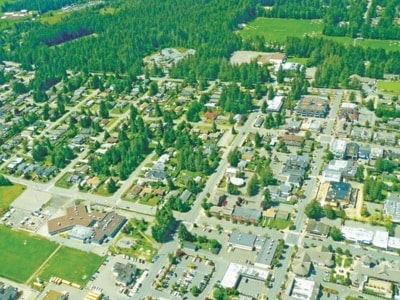When Qualicum Beach residents gathered in the Community Hall on Monday night, they had a big issue to tackle — one that stretches for blocks and blocks.
That issue, said Luke Sales, the town’s director of planning, is to determine how the town can encourage development infill in the uptown core.
That question however, had several components, some of which were deemed good enough to go on to the next level and several that were not.
“We are here to explore the barriers and incentives to development in the village neighbourhood,” Sales said, noting the Village Neighbourhood Planning Project had its origins in the town’s official community plan. He said development of the Village Neighbourhood — which could be described as the downtown core of the downtown core — forms a key initiative for the economic recovery of Qualicum Beach.
“The whole project is based on the goal that we want to densify, rather than continue to grow outwards” Sales said.
Monday night’s consultation meeting, he added, was a continuation of an earlier meeting held on May 28.
At issue was a series of questions about the village neighbourhood area, including whether height restrictions should be retained, whether the requirement for commercial development on the ground floor level should be scrapped, whether the town should purchase land in the area for development, get rid of development cost charges or scrap taxes for new developments.
Sales said the town had a maximum height allowance on buildings of three storeys — if the third storey is hidden in a peaked roof line.
The key, he said, was to determine whether allowing taller buildings would make developments more economically viable.
Issues to be considered in this regard, he said, include potential obstruction of views and potential impacts on the small town character of Qualicum Beach.
As well, he said the town is wrestling with the need to have a commercial ground floor for residential buildings in the core. Issues there, he said, include the difficulty in adapting to market conditions when commercial demand returns, loss of commercial continuity and potential loss of tax revenue for the town.
The issue of land consolidation, he continued, is nothing new, with the latest example being the purchase of the old school bus garage property. Potential problems with this idea include significant financial investment and the perception of interference in the market economy.
Lowering or eliminating development cost charges in the area, said financial manager John Marsh, could be seen as a way to encourage development, although he noted the lack of DCCs in the Nanaimo core doesn’t appear to have worked very well.
Also, he said while there would be no obvious immediate impact to town coffers, there would likely be one in the longer term.
There was no shortage of comment on the ideas, both positive and otherwise.
Luella Hollington kicked things off with a blistering critique of the process used to get to this point.
“The survey that went out was sent to a select group,” she said. “I was on a council for 11 years and we did a lot of surveys and never once do I recall sending a survey to only a select group. We always did a blind survey of a cross section of our population. I almost feel insulted by being ignored.”
On the question of DCCs, she stressed the need to be fair to everyone in the community, not just developers.
She said DCCs were first implemented in the 1990s in many communities because municipalities found they couldn’t afford to build and maintain infrastructure and needed another source of revenue.
The charges are levied on new development with the goal of paying for the municipal services to which they will be attached, such as water and sewer.
“If you eliminate them you will be going backwards and will be faced with the same problems we were faced with in the 1990s,” she said.
Bill Kritch stressed that council already has all the flexibility it needs.
“If a project comes forward that adds value to the town and is in the interest of the majority of the citizens, then council can approve a height variance right now,” he said. “That’s how The Gardens got built.”
Ed Hollington said getting rid of DCCs won’t revitalize the downtown as long as the real issues are ignored.
“The reason we have empty storefronts is because people shop in other places, like Wal-Mart and Costco,” he said. “They vote with their wallets and if you offer incentives, you will still have shut-up commercial space. The problem is that people do not shop locally. Fix that and you will fix everything else.”
Other comments called on council to stop being at war with developers, but rather, treat them with respect, as without developers, everyone would be living in tents.
Developer Dean Draeger, who built the structure that now houses Naked Naturals, put his case simply.
“I’m hoping we can come to a solution and work together,” he said. “It has to be fair to the community, the taxpayers and everybody, but if you give us some incentives, we are going to give you something you will be very proud of.”
Developer Dave Bryant went further, arguing that taking away the DCCS would mean a loss to the town of about $7,000 on a 1,000-square foot apartment.
“It’s really inconsequential at the end of the day,” he said. “If the market was booming, nobody would care.”
He said what developers are looking for is clarity.
“We are looking to know how much it is going to really cost us if we build,” he said.
Developer Zweitse de Witt said the town should stay out of the land base and avoid purchasing property for development.
“If you start competing with free enterprise, you don’t compete,” he said. “You’re dealing with taxpayers’ money.”
Passions were high on all sides of the debate, with the mayor having to call for calm and decorum on two occasions.
